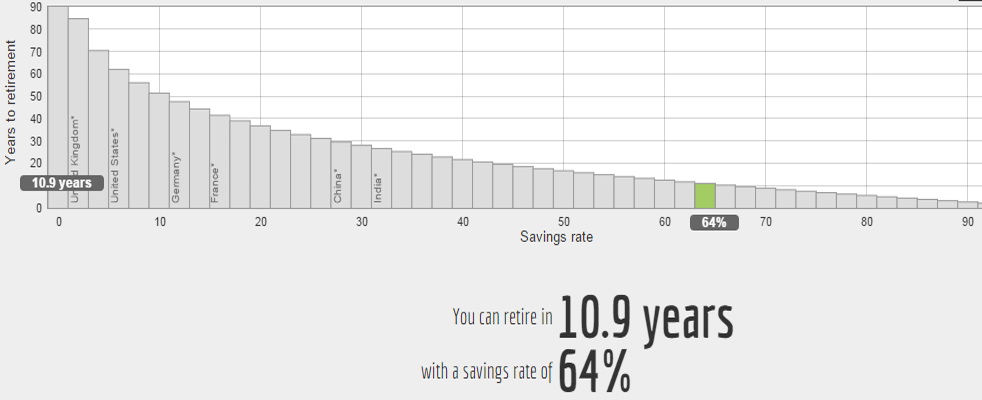

This brings me to a critical point: this study defines “success” as not going broke during a 30-year test period. In many years, retirees could have spent 5% or more of their savings each year, and still ended up with a growing surplus. Wade Pfau is one reasonable voice in the industry, and he created the following useful chart showing what the maximum safe withdrawal rate would have been for various retirement years:Īs you can see, the 4% value is actually somewhat of a worst-case scenario in the 65 year period covered in the study.
#THE SHOCKINGLY SIMPLE MATH BEHIND EARLY RETIREMENT REDDIT SERIES#
This simple but important series of calculations was called the Trinity Study, and since then it has been updated, tweaked, and reported on, and it’s still the subject of lots of debate today. Then they forced the retiree to spend an ever-increasing amount of his portfolio each year, starting with an initial percentage, then indexed automatically to inflation as defined by the Consumer Price Index (CPI).

They gave this imaginary retiree a mixture of 50% stocks and 50% 5-year US government bonds, a fairly sensible asset allocation. They analyzed what would have happened for a hypothetical person who spent 30 years in retirement between the years 1925-1955. Luckily, various Early Retirement Ninjas have done the work for us. So again, how do we find the right answer? But you can’t predict these things in advance. Ideally, you want to reach your magic retirement number in a time of nice, reasonable stock prices, just before the start of another long boom so that your retirement starts off on a good foot. In other words – the sequencing of booms and crashes matters.

Would you still have any money left today? On the other hand, if you retired in early 2000 while holding stocks, you saw an immediate and huge drop in your savings along with low dividend yields – and your ‘stash may be have had some scary times in the early days, and again around 2009. You’d be so rich by the time the 1929 crash and the Great Depression hit, that you’d barely notice the trouble in the streets from your rosewood-paneled tea room. If you happened to retire in 1921 on a mostly-stock nest egg, you would have experienced an enormous stock run-up for the first eight years of your retirement. More recently, the great financial crash and a slicing in half of of real estate and stock values. The abandonment of the gold standard for US currency and years of 10%+ inflation and 20%+ interest rates. The World Wars, Vietnam, and the Cold War. Over a long multi-decade period like the gigantic retirement you and I will be enjoying, enormous things have happened in the past.

In reality, stocks go up and down every year, and so does inflation. I admit it: that is the idealized and simplified version. I can already hear a chorus of whines and rattling keyboards starting up, so let’s qualify that statement. Inflation eats 3% on average, leaving you with 4% to spend reliably, forever. They pay dividends and appreciate in price at a total rate of 7% per year, before inflation. So where does this magic number come from?Īt the most basic level, you can think of it like this: imagine you have your ‘stash of retirement savings invested in stocks or other assets. If you use the number 25, you’re implicitly using a 4% Safe Withdrawal Rate, which is my own personal favorite number. The answers you get to this question vary widely.įinancial beginners (about 95% of the population) tend to randomly just throw out a number between 5-100 million dollars.įinancial advisers who aren’t Mustachians will tell you that it depends on your pre-retirement income, (with the implicit assumption that you are spending most of what you earn) and the end answer will be somewhere between 2 and 10 million.įinancial Independence enthusiasts will have the closest-to-correct answer: Take your annual spending, and multiply it by somewhere between 20 and 30. Will a box of eggs cost $6.00 a dozen when you’re 65, or will it be closer to $60? So how can we possibly know how much money we will need to live on in retirement? That sounds nice and simple, but many people consider it an unpredictable thing to nail down.Īfter all, you don’t know what sort of rollercoaster rides the economy will take your retirement savings on, and you also don’t know what rate of inflation will persist through your lifetime. The Safe Withdrawal Rate is the maximum rate at which you can spend your retirement savings, such that you don’t run out in your lifetime.


 0 kommentar(er)
0 kommentar(er)
